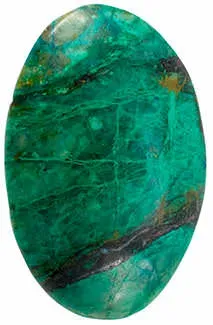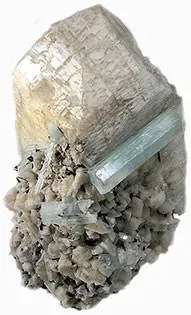 Microcline is a potassium aluminum silicate. The name Microcline is derived from the Greek words micros, meaning small, and klino meaning lean, because the cleavage planes in microcline deviate very slightly from 90 degrees. In one direction, it has perfect cleavage, but in another direction, the cleavage is only good, thereby forming almost perfect right angled prisms. Microcline has been appreciated for its beauty throughout history. It was used for both jewelry and ornamentation by the ancient Egyptians.
Microcline is a potassium aluminum silicate. The name Microcline is derived from the Greek words micros, meaning small, and klino meaning lean, because the cleavage planes in microcline deviate very slightly from 90 degrees. In one direction, it has perfect cleavage, but in another direction, the cleavage is only good, thereby forming almost perfect right angled prisms. Microcline has been appreciated for its beauty throughout history. It was used for both jewelry and ornamentation by the ancient Egyptians.
 Microcline belongs to the feldspar group of minerals, which is the most widespread group of minerals on earth. These minerals are found in very diverse kinds of rock: magmatic, sedimentary, metamorphic and plutonic. Though these are common stones, they are not very well known. Amazonite (named after the Amazon River) and Perthite are both varieties of microcline that are semi-precious stones. Amazonite is suitable for carving and polishing and is most commonly used in jewelry. It can be cut (usually en cabochon) to almost any size. Amazonite is a beautiful, deep blue-green color due to the presence of lead. It is frequently veined with white or yellow bands of plagioclase and is often therefore confused with pale jadeite or low quality
Microcline belongs to the feldspar group of minerals, which is the most widespread group of minerals on earth. These minerals are found in very diverse kinds of rock: magmatic, sedimentary, metamorphic and plutonic. Though these are common stones, they are not very well known. Amazonite (named after the Amazon River) and Perthite are both varieties of microcline that are semi-precious stones. Amazonite is suitable for carving and polishing and is most commonly used in jewelry. It can be cut (usually en cabochon) to almost any size. Amazonite is a beautiful, deep blue-green color due to the presence of lead. It is frequently veined with white or yellow bands of plagioclase and is often therefore confused with pale jadeite or low quality ![]() turquoise. Perthite is quite different in appearance. It displays a leopard-like pattern within the stone that is caused by lamellar intergrowths inside the crystal. Crystals display colored stripes, which are composed of microcline, and white or clear stripes, which are actually plagioclase feldspars.
turquoise. Perthite is quite different in appearance. It displays a leopard-like pattern within the stone that is caused by lamellar intergrowths inside the crystal. Crystals display colored stripes, which are composed of microcline, and white or clear stripes, which are actually plagioclase feldspars.
 Microcline rates a 6 to 6.5 on the Moh's hardness scale. It has a vitreous to silky luster, and can sometimes be dull if weathered. Crystals are usually translucent to opaque, but can also be perfectly translucent. These translucent stones are of more value. A form of alkali feldspar, microcline may be many different colors: colorless, white, off-white, brown, yellow, pink, red, gray, green, or blue green. Stones display no pleochroism. Microcline is found in a number of different kinds of metamorphic rocks. It can be found in granites, granite pegmatites, hydrothermal veins, and in many schists and gneisses. It is also found as grains in sedimentary rocks. It is most widely found in the form of minute crystals in rocks, however large crystals can be found specifically in pegmatites. In fact, microcline can form the largest known crystals of any mineral, and large specimens come to market often.
Microcline rates a 6 to 6.5 on the Moh's hardness scale. It has a vitreous to silky luster, and can sometimes be dull if weathered. Crystals are usually translucent to opaque, but can also be perfectly translucent. These translucent stones are of more value. A form of alkali feldspar, microcline may be many different colors: colorless, white, off-white, brown, yellow, pink, red, gray, green, or blue green. Stones display no pleochroism. Microcline is found in a number of different kinds of metamorphic rocks. It can be found in granites, granite pegmatites, hydrothermal veins, and in many schists and gneisses. It is also found as grains in sedimentary rocks. It is most widely found in the form of minute crystals in rocks, however large crystals can be found specifically in pegmatites. In fact, microcline can form the largest known crystals of any mineral, and large specimens come to market often.
 Well formed microcline crystals can be quite striking in appearance. Microcline often forms crystals in association with
Well formed microcline crystals can be quite striking in appearance. Microcline often forms crystals in association with ![]() quartz, known as graphic granite. When this mixture is formed between gem quality amazonite and smoky quartz, the result is beautiful and highly coveted. Other associated minerals include muscovite and the plagioclase feldspars. Fine microcline crystals occur in Brazil, the United States (in the Pikes Peak region of Colorado as well as Virginia and North Carolina), Norway, the Soviet Union (in the Ural Mountains), India, and in Italy, in the granite of Madalena Island. Crystals can also be found in Australia, Zimbabwe, Mozambique, Namibia, Canada, Madagascar, and Tanzania.
quartz, known as graphic granite. When this mixture is formed between gem quality amazonite and smoky quartz, the result is beautiful and highly coveted. Other associated minerals include muscovite and the plagioclase feldspars. Fine microcline crystals occur in Brazil, the United States (in the Pikes Peak region of Colorado as well as Virginia and North Carolina), Norway, the Soviet Union (in the Ural Mountains), India, and in Italy, in the granite of Madalena Island. Crystals can also be found in Australia, Zimbabwe, Mozambique, Namibia, Canada, Madagascar, and Tanzania.